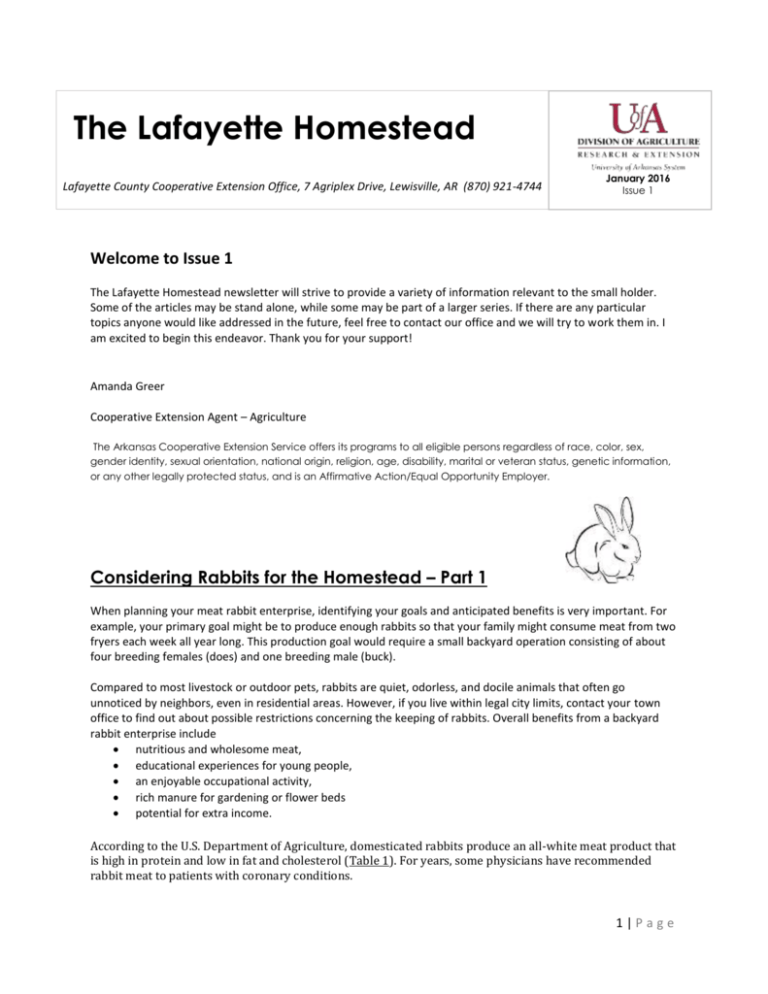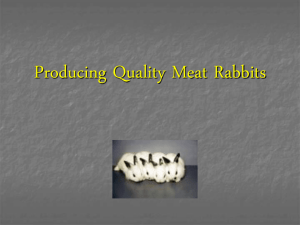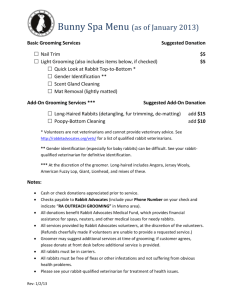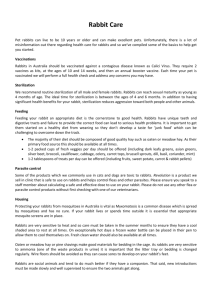Lafayette Co Horticulture Newsletter February 2015
advertisement

The Lafayette Homestead Lafayette County Cooperative Extension Office, 7 Agriplex Drive, Lewisville, AR (870) 921-4744 January 2016 Issue 1 Welcome to Issue 1 The Lafayette Homestead newsletter will strive to provide a variety of information relevant to the small holder. Some of the articles may be stand alone, while some may be part of a larger series. If there are any particular topics anyone would like addressed in the future, feel free to contact our office and we will try to work them in. I am excited to begin this endeavor. Thank you for your support! Amanda Greer Cooperative Extension Agent – Agriculture The Arkansas Cooperative Extension Service offers its programs to all eligible persons regardless of race, color, sex, gender identity, sexual orientation, national origin, religion, age, disability, marital or veteran status, genetic information, or any other legally protected status, and is an Affirmative Action/Equal Opportunity Employer. Considering Rabbits for the Homestead – Part 1 When planning your meat rabbit enterprise, identifying your goals and anticipated benefits is very important. For example, your primary goal might be to produce enough rabbits so that your family might consume meat from two fryers each week all year long. This production goal would require a small backyard operation consisting of about four breeding females (does) and one breeding male (buck). Compared to most livestock or outdoor pets, rabbits are quiet, odorless, and docile animals that often go unnoticed by neighbors, even in residential areas. However, if you live within legal city limits, contact your town office to find out about possible restrictions concerning the keeping of rabbits. Overall benefits from a backyard rabbit enterprise include nutritious and wholesome meat, educational experiences for young people, an enjoyable occupational activity, rich manure for gardening or flower beds potential for extra income. According to the U.S. Department of Agriculture, domesticated rabbits produce an all-white meat product that is high in protein and low in fat and cholesterol (Table 1). For years, some physicians have recommended rabbit meat to patients with coronary conditions. 1|Page Table 1. Nutritional Value of Rabbit and Other Common Meats Skinless Meat Protein (%) Fat (%) Calories (per oz.) Cholesterol (mg per oz.) Rabbit 1 22.8 6.3 44 55 Beef 2 29.9 10.1 61 73 Catfish 3 22.3 5.9 40 20 Chicken 4 28.9 7.4 54 80 Lamb 28.1 9.5 58 78 27.7 14.8 60 72 28.9 4.9 48 65 Pork 5 6 Turkey 4 Source: USDA 1 Wisconsin Meat Facts and Analysis, Fact Sheet ME 87-3, USDA Handbook 8-17, 1989 (whole carcass) 2 USDA Handbook 8-13 Reo., 1989. (composite sample) 3 NutriFacts Seafood. (whole) 4 USDA Handbook 8-5, 1979. (composite sample) 5 USDA Handbook 8-10, 1991. (composite sample) 6 USDA Handbook 8-17, 1989. (composite sample) As an occupation or hobby, whether for the young, the elderly, or any family member, raising rabbits can be an enjoyable and family focused activity. The time or labor required to raise rabbits is about 20 hours per breeding doe per year. For the backyard operation with four breeding does, this labor input is equal to just 1½ workweeks (60 hours) per year, or less than 15 minutes per day. However, many families enjoy spending more time than this with their rabbits. Rabbit farming complements the efforts of the serious gardener and flower grower. The manure from rabbits makes excellent compost, rich in organic matter and nutrients (Table 2). Commercial redworms or nightcrawlers grown in rabbit manure produce a superb and fairly odorless organic material. Many commercial rabbit producers sell both the organic material in bags and bait worms in cartons as a supplemental source of income. If your family enjoys fishing, you will also have a regular supply of bait worms. Table 2. Composition (%) of Manure from Livestock Animal Nitrogen Phosphorus Potassium Rabbit 3.71 1.33 3.47 Cattle 2.90 0.72 2.14 Poultry 4.70 1.58 1.03 Swine 3.52 1.60 1.00 Source: Various reports from the literature The small size of the backyard rabbit enterprise, typically four to five breeding does, represents steady meat production at minimal investment and operating costs. It takes little time or money to either scale down or expand the size of the operation. The labor required can be shared among almost all family members. These features mean that the rabbit enterprise carries minimum economic risk. This favorable “economy of scale” is highlighted in the budget shown in Table 3. The bottom line of the budget shows a net return per doe over annual costs, not including the cost of the buck or the building. This figure considers 30 fryers produced from one doe that are consumed or sold, based on an average market value per 4½-pound live fryer at 10 weeks of age. If the rabbitry is well managed, the family should be rewarded with wholesome and delicious meat at a reasonable cost. Each producer should evaluate the economics of rabbit raising on a regular basis looking at costs of production and net return. 2|Page Table 3: Projected Budget per Doe for Backyard Rabbit Farming (Jan. 2014) Life Span (years) Purchase Cost ($) Annual Cost ($) Start-up Costs* Initial doe purchase 1 year 45.00 Cage (30 x 30 x 18 in.) 5 years 50.00 10.00 Feeder (91/2 in.) 5 years 4.00 .80 Water bottle (32 oz.) 5 years 4.00 .80 Nest box 5 years 11.75 2.35 Shipping 24.00 4.80 Subtotal 138.75 18.75 Annual Operating Costs** Feed 175.00 Utilities (electricity, water, etc.) 10.00 Veterinary/Misc. supplies 10.00 Subtotal 195.00 Annual Returns*** Value of 30 fryers (consumed or sold) 262.50 Return over investment 123.75 Return over annual costs 67.50 * Building and buck costs not included. Costs of these will change return over annual costs. Labor is assumed to be shared by the family and therefore does not represent an annual cost. **Feed reflects consumption by doe, 30 fryers from 6 litters, and one replacement doe fed to breeding age (5 months). ***Based on $1.75 per pound market value for 5-pound rabbit at 10 weeks of age.Make sure you evaluate your market before you start raising rabbits. Courtesy of Maine Cooperative Extension Service ***We will continue the discussion of rabbits in future issues*** -------------------------------------------------------------------------------------------------------------------Upcoming events/notifications: Arkansas Flower and Garden Show Statehouse Convention Center, Little Rock. Feb 26-28, 2016 Arkansas Women in Ag Conference Location TBD, Little Rock. March 10-11, 2016 South Arkansas Homestead Conference Pioneer Village Rison AR. Sat. April 9, 2016 3|Page Fertilizing Onions Fertilization of onion plants is important to have a successful harvest. Research has shown that applying fertilizer at planting can increase growth and yield. Banding of phosphorus at planting, such as super phosphate (0-20-0) 2-3 inches below the seed by making a trench 3 inches deep, distributing ½ cup of super phosphate per 10 row feet within the trench, covering it with soil, then sowing seed and covering the seed lightly with ½ inch or less of soil can improve productivity. Once plants are established, onions should receive additional fertilizer such as Ammonium sulfate (21-0-0-24S) or Ammonium nitrate (34-0-0) as a side-dress application each month as onions require a high source of nitrogen. These products can be applied at the rate of one cup per 20 feet of row, if using Urea (46-0-0) cut this rate in about half. Do not apply urea to wet soil or you will lose some of the nitrogen and try to incorporate if possible. Other nitrogen containing fertilizers may be used as well, such as 13-13-13, etc. but be sure to adjust use rates according to bag analysis. The first nitrogen application should begin about three weeks after planting and continue with subsequent applications every 2-3 weeks up until the time when the neck of the onion starts feeling soft. At that point fertilizer applications should end. Sulfur is an essential element for onion growth and increases bulb weight, but can make onions pungent/hotter, especially if applied too late in the season. Sulfur is not generally applied to Vidalia type or sweet onions. If you like your onions hot or if your soil is lacking in adequate sulfur, then you may consider applying. Sulfur should be applied early. Do not apply sulfur after late January. If you are planning on using ammonium sulfate as a nitrogen source you should not need additional sulfur. There are different sulfur products available, but are commonly found as either an elemental powder with a 90% concentration, or ‘garden sulfur’ which is generally a 49% form. Elemental sulfur is a strong soil acidifier and should only be applied the year preceding the crop. Garden sulfur, the most commonly found, is in the sulfate form and can be applied at planting time. General sulfur recommendations on onions, garlic, and shallots is 20 lbs SO4-S/acre or around 1/2 tablespoon garden sulfur per 10 row ft. Organic gardeners should have worked in a nice, finished compost containing when building the beds. Manure analysis for fertilizer value can be done through our office for a fee. Animal manure is an excellent source of both nutrients and organic matter. Animal bedding, such as chicken litter, also falls into this category. One disadvantage to using manure is that it often contains weed seeds. It may also harbor potential human pathogens like E.coli and salmonella. For that reason, only aged/composted manure should be applied. Manure should only be used at least 120 days before harvest, not be applied as a sidedressing to reduce risk. It would be advised to incorporate manures into your garden in the fall for the next year. Lime may be necessary if soil tests show that the soil is too acidic particularly if one has been using a lot of sulfur in the garden. --------------------------------------------------------------------------------------------------------------------- Building Rain Barrels to Harvest Rainwater - FSA9534 Attached! 4|Page Arkansas 4-H Poultry Chain The 4-H Poultry Chain is designed to teach youth members how to care for the family laying flock. Many families are interested in keeping poultry and this is a good way to get started and increase your laying production as the hens provided are efficient, high egg producing hens. Number of chicks provided each year varies, between 25 – 50. Prices for the chicks vary on the number of chicks received but are at a discounted rate. Since they are prepaid, the pullets no longer have to be returned for sale at the end of the year. The pullets may also be shown by the participating youth in the county fair. Poultry chain participants must by youth aged 5 (By Jan. 1st) – 18 and be enrolled in 4-H Online and interested in poultry as a project. This year each county will be receiving Bovan Browns (photo below). These are commercial brown eggers. Delivery dates provided by the hatchery will be May 7 and 14 unless the schedule changes. If anyone is interested in poultry chain, contact our office. Bovan Browns: http://centurionpoultry.com/BB-SpecSheet.pdf 5|Page



